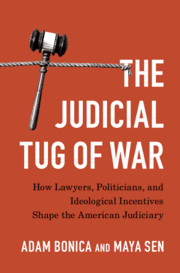 The Judicial Tug of War
The Judicial Tug of War Book contents
- Frontmatter
- Dedication
- Contents
- List of Figures
- List of Tables
- Acknowledgments
- 1 Introduction: The Tug of War Over the American Judiciary
- I The Legal Profession and the “Captured Judiciary”
- 2 The “American Aristocracy”
- 3 The Bar, Self-Regulation, and Judicial Capture
- II Political Actors and the Incentive to Politicize
- III Ramifications of the Judicial Tug-of-War
- Bibliography
- Index
- Other Books in the Series
3 - The Bar, Self-Regulation, and Judicial Capture
from I - The Legal Profession and the “Captured Judiciary”
Published online by Cambridge University Press: 09 December 2020
- Frontmatter
- Dedication
- Contents
- List of Figures
- List of Tables
- Acknowledgments
- 1 Introduction: The Tug of War Over the American Judiciary
- I The Legal Profession and the “Captured Judiciary”
- 2 The “American Aristocracy”
- 3 The Bar, Self-Regulation, and Judicial Capture
- II Political Actors and the Incentive to Politicize
- III Ramifications of the Judicial Tug-of-War
- Bibliography
- Index
- Other Books in the Series
Summary
How has a profession that has made itself so essential to the workings of every aspect of the political process – including the regulatory process – remained unburdened by government oversight and accountable only to itself? This is the question we address in Chapter 3. As we document in this chapter, the power of the bar led to an uneasy alliance between political actors; the bar sought more and more autonomy and, in line with a long-standing and natural connection with the judiciary, began to professionally “capture” the judiciary. It did so not only by monopolizing the candidate pool of potential judges but also by instituting rules about how lawyers (i.e., future judges) should be educated, implementing codes of judicial conduct, and, ultimately, making binding recommendations on how judges should be selected. In turn, the government has entrusted the “captured judiciary” with regulatory power over the legal profession. As we show through both qualitative and quantitative evidence, this symbiotic arrangement furthered the bar’s political and economic power.
- Type
- Chapter
- Information
- The Judicial Tug of WarHow Lawyers, Politicians, and Ideological Incentives Shape the American Judiciary, pp. 71 - 102Publisher: Cambridge University PressPrint publication year: 2020


